“Perennials” are plants that come back every year… at least in theory. In reality, some perennials are short-lived and only come back for a few years. Others may come back every year, but not necessarily where you planted them – they pop up in other places, or dramatically expand their territory. Some perennials need to be divided (split at the roots) to stay vigorous, or they will languish and stop blooming.
Baptisia (“Wild Indigo” or “False Indigo”), on the other hand, is truly perennial. There are documented cases of gardens, abandoned and neglected for over 30 years, where the only remaining original plant was Baptisia – still growing right where it was first planted, and still blooming.
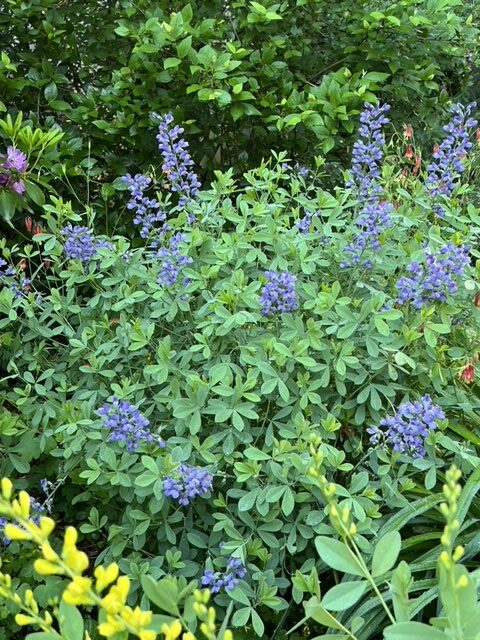
Baptisia is as beautiful as it is durable. It sends up vertical stalks loaded with flowers in May and June. All summer long, it acts like a shrub, 3 to 4 feet tall and wide, with blue-green foliage that remains fresh even in the hottest weather. In the fall, it produces attractive pods that add seasonal interest. The whole plant dies back to the ground after a few hard frosts, remaining unharmed by snow mounds or road salt throughout the winter. In spring, this reliable perennial definitely returns.
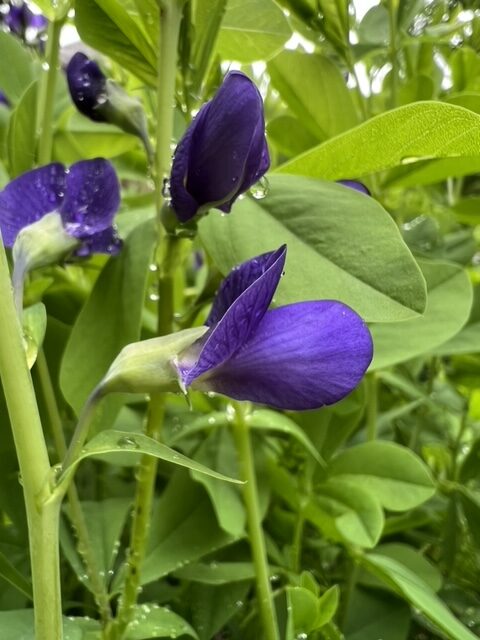
Baptisia evolved growing in open meadows and prairies. It is in the legume family, which explains the sweet-pea shape of the flowers. Like other legumes, Baptisia is nitrogen-fixing. Essentially, the plant manufactures its own nitrogen fertilizer, so it can live in very poor soil. Baptisia roots can extend 7 feet deep, even into hard-packed prairie, so it is drought tolerant.
Though Baptisia is easy to find in plant nurseries, you may be inclined to give it a pass when you first see it. It looks a bit like purple asparagus coming up in early spring. Because of its deep roots, nurseries can offer only very young plants, but a small plant will fill out dramatically after two or three years in the ground.
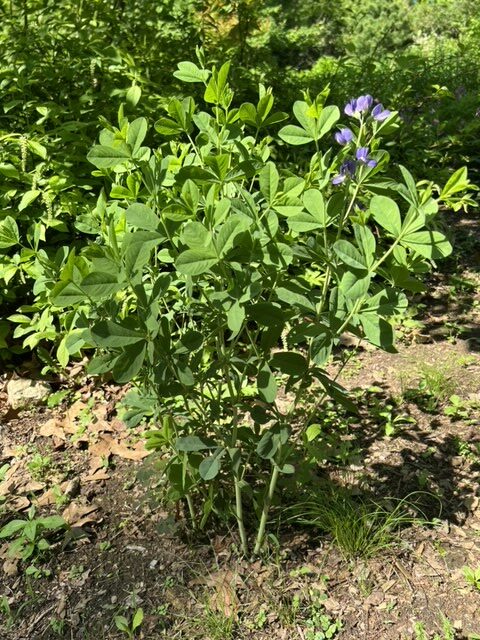
Baptisia is very low maintenance. It never needs dividing. In fact, once its deep roots are established, it really should not be moved or divided. The best bet is to buy container plants and give them enough room to mature undisturbed. Note, however, that the one non-negotiable for Baptisia is sun – 8 to 10 hours a day. Even very long-established plants will begin to fade if they become shaded by trees and shrubs. So, plan ahead when deciding where to site Baptisia.
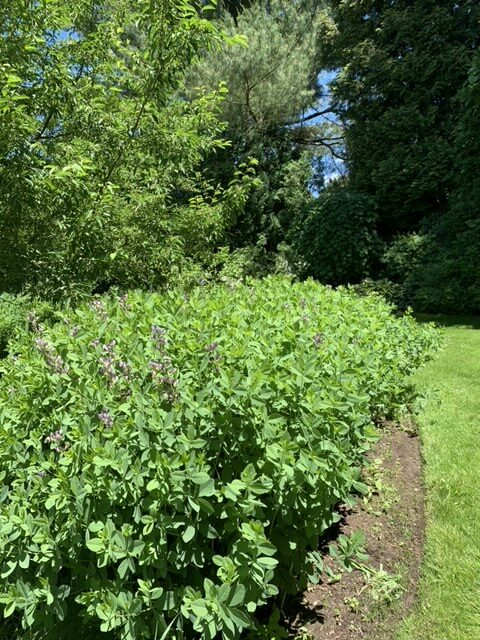
There is a lot to choose from in the Baptisia family these days – at least 3 garden-worthy species, plus hybrids and cultivars. Here are a few favorites:
Baptisia australis, or Wild Blue Indigo, is a species native to New York and always our first choice. Its natural habitat varies from moist woodland edges to open prairie. Its original native range extends south as far as Georgia and west from Nebraska to Texas. It likes our acidic soil, and is hardy in Zones 4-9. It is not generally attractive to deer, and it is the host plant for the Wild Indigo Duskywing butterfly.
Baptisia sphaerocarpa (Yellow Wild Indigo) is not native to New York, but is native farther west and south from Missouri and Oklahoma to Texas. Baptisia alba (White Wild Indigo) is native in the Southeast from Virginia to Florida. Both of these Baptisia species are winter hardy to Zone 5, and do well in New York gardens.


Interestingly, these three Baptisia species have yielded natural hybrids resulting in some very beautiful flower color variations. Hybrids called ‘Purple Smoke’ and ‘Twilight Prairie Blues’ are often available and seem to perform as well as the species.
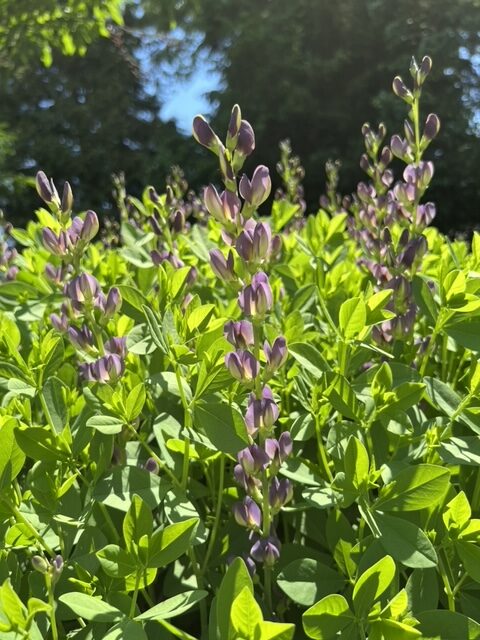
New cultivars have been developed by growers and are sold under various names such as ‘Lemon Meringue,’ ‘Dutch Chocolate,’ and ‘Cherries Jubilee.’ Whether these cultivars provide the same benefits to wildlife as the species is unknown.
So, if you want a true perennial that will come back every year, never need dividing, never need fertilizing, and will be beautiful for many years to come, try Baptisia!


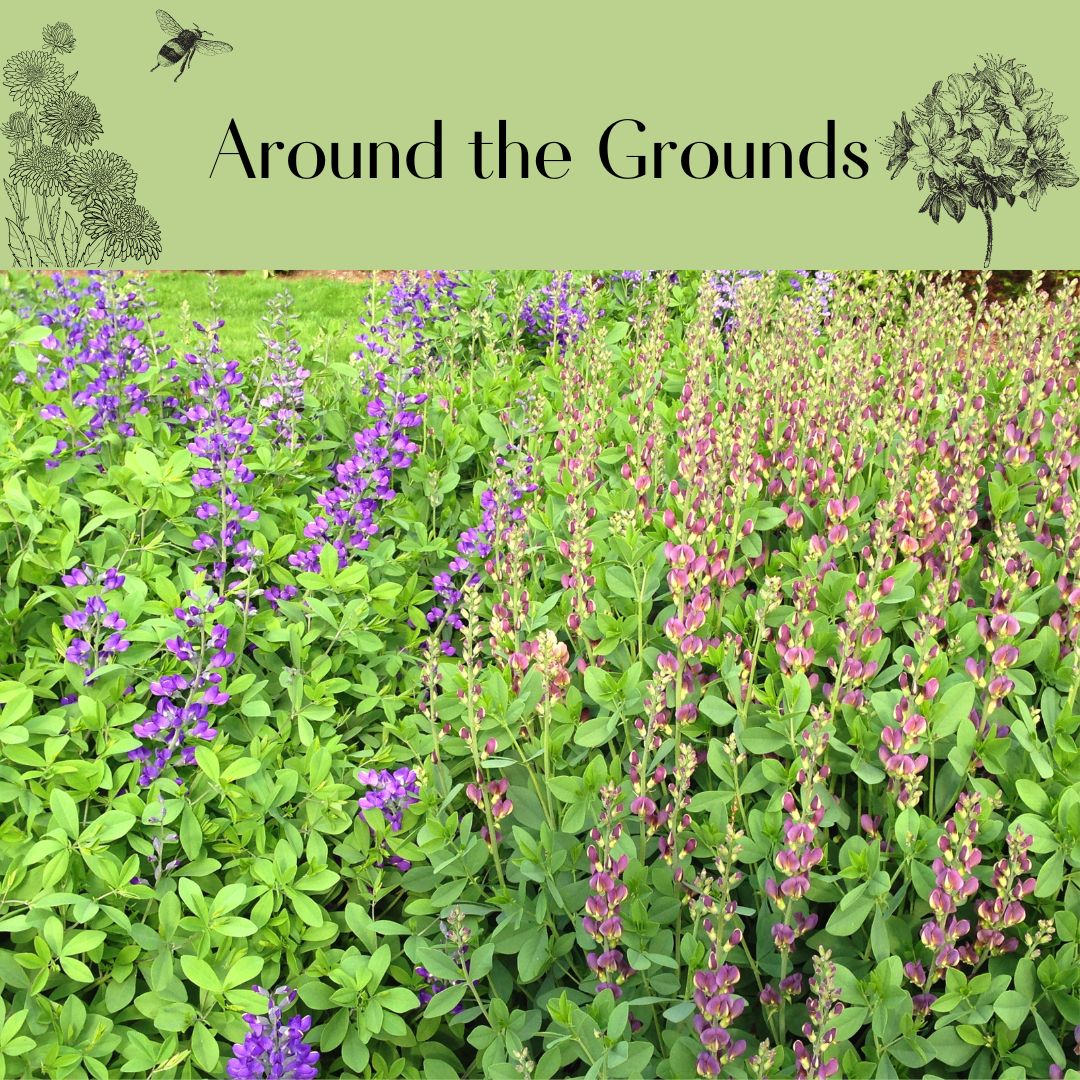
I planted Baptisia last year and it took off beautifully. It’s nearly May now and everything else around it has greened up. The Baptisia hasn’t emerged. Does that mean it’s dead?
Baptisia can be slow to emerge. It looks like little asparagus spears as it comes up through the soil. I have missed seeing it break ground, but unless it gets stomped on or damaged, it should be ok. Fingers crossed!
If you don’t cut off those seed pods, you will be overtaken within a very few years!
Really! Your Baptisia must be in a perfect spot! I have seen a few seedlings come up, and friends have had success propagating Baptisia from seed, but I’ve never seen it really take off. You must be doing everything right! Maybe hand out some seedlings to friends and neighbors — more Baptisia in the ecosystem is a good thing!
What are the pods growing on my false indigo? Any thoughts on why my false indigo aren’t blooming. Get plenty of sun and otherwise healthy plants.
Are they new plants from a grower? If so, they likely bloomed before you planted them. The pods are the seeds that developed from flowers that were fertilized. (Baptisia is in the legume family so the flowers and the seeds look like peas and beans.) If you have pods, you definitely had flowers earlier. In southern NY, Baptisia is blooming now. But the time of bloom can be accelerated or delayed by weather. The presence of pods now means they definitely bloomed earlier. Pods usually form in late summer and hang in into fall. They may have been grown farther south and bloomed before you planted them. Or, if they are established in your garden, perhaps the foliage concealed the flowers and you missed them?
if it has seed pods on it, then it has bloomed. It may not be blooming well so you’re missing the blooms when they arrive, but they are definitely blooming .
Can it ever be moved or divided?
I have never tried it, Susan, but the usual advice in the literature is that Baptisia “resents” being disturbed. I take that to mean the plant is weakened or killed in the process. I’m sure it can be relocated in the first year or two, but once the roots are down deep, it would be difficult to get the whole thing out of the ground without severe root pruning. It would be worth the gamble if the only option is losing the plant anyway because of construction or too much shade, etc. But if it’s happy where it is, I would leave it alone.
Pretty and *actually* perennial? Sounds like a winner to me. It looks like you can also use the shoots as an asparagus substitute – have you tried them out?
I would not recommend eating the shoots. I see that some writers claim the new shoots of one of the species are edible, but others advise that they are toxic in any quantity. I think I would forage for a few other edible plants before Baptisia.
Great column on Baptisia, Cathy. It is currently on my favorite list because it is one of only about only 5 plants left in my garden that the deer don’t eat. I’m currently on a quest to fine more of this plant, but nurseries seem to be out. BTW, we both live near the Sprainbrook Nursery, which has been left to go wild since it closed 10 years ago. I just notice there is a fine plant of Baptisia in full bloom on its overrun property. Root is probably 7 feet deep!
Amazingly carefree plant, right? I’ve heard of plants living more than 30+ years, but I have no idea how long they can survive neglect beyond that. I suspect the true species are more durable than the newer cultivars, but I’ve had “Twilight Prairie Blues” (one of the early hybrids) going strong for over a decade. Rabbits and woodchucks don’t touch it, either.
I saw the blooming Baptisia at Sprainbrook! Thanks for pointing it out! That must be at least 5 years with no watering or anything. Amazing!